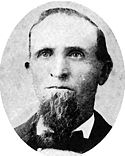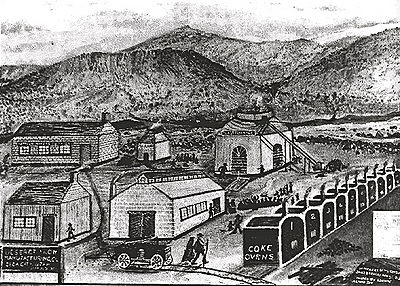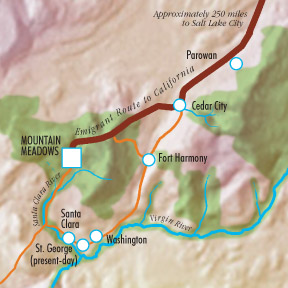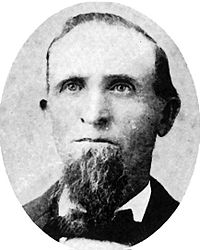Andrew A. Allen
Andrew Allen, his personal and family background, and his alleged involvement in the Mountain Meadows Massacre
Andrew Augustus Allen
1836-1907
Biographical Sketch
[The main source linking Andrew Augustus Allen to the massacre is the 1859 arrest warrant which listed Ira Allen "and son." In Massacre at Mountain Meadows, Walker, et al, do not mention Andrew Allan in Appendix C, their detailed list of the involved militiamen. No other source mentions Andrew Allen. He probably was not present at the massacre.]
Early Life
Andrew Augustus Allen, the son of Ira Allen and Calista Bass, was born in 1836 in Woodstock, Windham County, Connecticut. He accompanied his familly to Michigan where, evidently, they heard the Mormon message.
Journey to Utah
In 1845, the Allen family joined the Mormon settlers in western Illinois and, following the difficulties there, they later immigrated to Utah Territory.
In is not certain which company the Allens joined to travel the overland trail to the Great Basin. Late in life Andrew Allen recalled that they crossed the plains in 1850. They must have remained around Kanesville, Iowa (later Council Bluffs) for several years while they gathered the means to immigrate to Utah Territory.
It is known that 1850 was a very heavy season on the overland trail, with more than 50,000 bound for the California Gold Rush or Oregon. The trails were heavily overgrazed that year. Cholera was epidemic that season and well over a thousand graves were counted on the trail. The Allen family would have passed the usual milestones on the trail: Fort Kearney, the South Fork of the Platte River, Chimney Rock, Fort Laramie, the Sweetwater River, Independence Rock, Devil's Gate, Green River, Fort Bridger, Bear River, and Weber River. After suffering the usual hardships of overland trail they arrived in the valley of the Great Salt Lake in late summer or early fall.
To Cedar City and the Ironworks
In the early 1850s, the Allen family lent their aid to the newly founded Iron Mission headquartered in Cedar City in southern Utah. In 1857, 21-year-old Andrew Allen married Sarah Ann Cartwright, the daughter of Thomas Cartwright (a massacre participant) and Sarah Yates). The Cartwrights were emigrants from Lancashire, England.
In moving to Cedar City, the Allen family was settling in an area dominated by the Deseret Iron Company, known more familiarly as the Ironworks. See Summary of Deseret Iron Company for a brief summary of its early development.
The Ironworks in 1857
In April 1857, the delivery of a new steam engine from Great Salt Lake City seemed to breathe new life into the ironworks. Working from April to June they installed the steam engine and completed the new engine house. In the first week of July, they were ready to begin smelting. They “put on the blast” and had a modicum of success. But they continued to be plagued with problems ranging from poor quality raw materials to smelting equipment that lacked technical sophistication. When in late July the steam engine seized with sand from the dirty creek water, they speedily dug a reservoir to store a supply of clean water for the boiler. They continued making smelting runs through August. All the while crews at the ironworks manned all the necessary functions there, while other crews, mainly miners and teamsters, gathered the raw materials – iron ore, coal, limestone, and wood – necessary to sustain smelting.
The smelting continued until September 13. In other words, around September 3, when a dispute arose between some settlers and several men in the passing Arkansas company, the blast furnace was running nonstop. And when Cedar City militiamen, many of them ironworkers, mustered to Mountain Meadows where they were involved in the massacre on September 11, other ironworkers in Cedar City continued the smelting runs night and day. For additional details, see Smelting at the Ironworks in 1857.
The 1857 Ironworkers
From late April to September, those working up the canyon in mining or hauling wood, coal, limestone, rock, sand or “adobies” to the ironworks were Isaac C. Haight, James Williamson, George Hunter, Joseph H. Smith, Ira Allen, Ellott Wilden, Swen Jacobs, Alex Loveridge, Joel White, Ezra Curtis, Samuel McMurdie, Samuel Pollock, John Jacobs, John M. Higbee, John M. Macfarlane, Samuel Jewkes, Nephi Johnson, Thomas Cartwright, William Bateman, Elias Morris, Benjamin Arthur, Joseph H. Smith, Robert Wiley, and Philip Klingensmith. Those working at the ironworks on the furnace, engine, coke ovens or blacksmith shop included Elias Morris, John Humphries, Ira Allen, John Urie, Benjamin Arthur, James Williamson, Joseph H. Smith, Samuel Jewkes, Joseph Clews, Richard Harrison, William C. Stewart, William Bateman, John M Macfarlane, John M. Higbee, John Jacobs, George Hunter, Samuel Pollock, William S. Riggs, Alex Loveridge, Ellott Wilden, Ezra Curtis, Eliezar Edwards, Swen Jacobs, Joel White, and Thomas Cartwright. (The two lists overlap because some worked both in the canyon and at the Ironworks.) Other prominent figures at the ironworks who were not later involved at Mountain Meadows were Samuel Leigh, George Horton, James H. Haslem, Laban Morrell, John Chatterley, Thomas Gower, Thomas Crowther and others.
Andrew's father, Ira Allen, was involved in a variety of tasks. In April, he hauled some the parts of the steam engine from Great Salt Lake City to southern Utah. When they were building a new room to house the steam engine, Allen tended the masons. Later, he worked on the canyon road up to the coal mines and hauled "adobies" to the Ironworks. He helped level the floor in the new engine room. In August, he helped create the reservoir to supply clean water to the steam engine. When they made the iron run that month, Allen was among the teamsters who hauled coal to sustain the run. Andrew Allen may have assisted his father in some of these tasks.
In the Iron Military District: Sergeant Andrew Allen, Company E, in Isaac Haight's 2nd Battalion
In 1857, the Iron Military District consisted of four battalions led by regimental commander Col. William H. Dame. The platoons and companies in the first battalion drew on men in and around Parowan. (It had no involvement at Mountain Meadows.) Major Isaac Haight commanded the 2nd Battalion whose personnel in its many platoons and two companies came from Cedar City and outer-lying communities to the north such as Fort Johnson. Major John Higbee headed the 3rd Battalion whose many platoons and two companies were drawn from Cedar City and outer-lying communities to the southwest such as Fort Hamilton. Major John D. Lee of Fort Harmony headed the 4th Battalion whose platoons and companies drew on its militia personnel from Fort Harmony, the Southerners at the newly-founded settlement in Washington, the Indian interpreters at Fort Clara, and the new settlers at Pinto.
By summer 1857, Andrew Allen was a sergeant in one of the platoons in Company E, Captain Elias Morris's company in Major Isaac Haight's 2nd Battalion. See A Basic Account for a full description of the massacre.
While there is no doubt that his father Ira Allen played a well-documented role in the massacre, there is considerable doubt about Andrew's involvement. The 1859 arrest warranty named, among others, Ira Allen "and son". Yet none of the other sources identify Andrew as a participant. If he was involved, nothing is known of his role.
Later Life
The dual disasters of the massacre and the failure of the Ironworks caused many to abandon Cedar City in 1858-59 for other parts. Among them were Ira Allen and his family. They moved to Cache Valley in northern Utah and helped found the settlement of Hyrum.
The Allen family reminded in Cache Valley for the next decades. Allen had five children with his first wife, Sarah Ann. In 1887, he married Rebecca Christine Nielsen, the daughter of Danish emigrants. She bore him seven more children. Allen held various civic and church positions in Hyrum.
Final Years
He died in 1907 in Hyrum, survived by his second wife and his children.
References
Esshom, Pioneers and Prominent Men of Utah, 714; New.familysearch.org; and Walker, et al, Massacre at Mountain Meadows, Appendix C, 393, fn. 2.
For full bibliographic information see Bibliography.
External Links
For further information on Andrew Allen, see:
Further information and confirmation needed. Please comment or contact 1857_militia@roadrunner.com.




